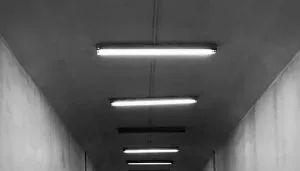
PCBs – the common term for polychlorinated biphenyls – are toxic manufacturing compounds that do not occur in nature and have been linked to various health problems with the liver, thyroid, skin, and eyes. Moreover, they have been classified as probable human carcinogens by the EPA and the International Agency for Research on Cancer (IARC), based on animals studies that provided conclusive evidence that PCBs cause cancer. And they are commonly found in light ballasts and building materials in schools.
PCBs were manufactured by Monsanto for use in a multitude of products, from floor finishers and oil paints, to caulk, carbonless copy paper, and the ballast contained in fluorescent lights. They are nonflammable, chemically stable, and excellent electrical insulators, making them convenient and versatile in the manufacturing process. However, the price for these manufacturing conveniences – the disastrous consequences they can have on health – is far too steep to pay, and in 1979, they were effectively banned by the U.S. government. But this should have been only the first step – and the next steps have been slow in coming.
The health threats posed by products containing PCBs didn’t disappear with the manufacturing ban. PCBs have very slow decomposition rates and retain their toxicity even in very low concentrations. Animals that ingest them can then pass them up the food chain and contaminate an entire ecosystem. And this isn’t even touching on schools – where testing consistently turns up high concentrations of PCBs.
However, there is no consistent testing. No federal regulations require cleanups, or even reports, of PCBs. A similarly hazardous material, asbestos, led to the Asbestos Hazard Emergency Response Act (AHERA) implemented by the Environmental Protection Agency (EPA). This law requires all public schools–as well as private charter and religious schools––to be inspected and to implement a rigorous remediation plan if asbestos is found.
By stark contrast, PCB testing and remediation in schools are not required but rather are left to a state’s discretion. And most states do not have comprehensive plans in place to clean up or even identify contaminated schools.

Illinois has laws that protect aquifers and other sources of potable water from PCB contamination, but none that protect schools. Any schools built or remodeled during the era of PCB manufacturing, over the course of 50 years from 1929 until the late 1970s, would be at serious risk of PCB contamination, most commonly from caulk and the ballast leaking from broken fluorescent lighting fixtures. A 2016 study from the Harvard School of Public Health estimated that this impacts anywhere between 13,000 and 26,000 schools, and up to 14 million students in the United States. Some of the most vulnerable children are being put into toxic environments for years at a time, and there are very few controls in place to safeguard them.
Which is why a new lawsuit filed by the state of Vermont and its Attorney General Charity Clark against Monsanto for the PCBs in Vermont schools is such a big deal. The lawsuit alleges that for decades, Monsanto knowingly produced products with dangerous PCBs and was aware of these many dangers long before the federal ban in 1979.
The lawsuit against Monsanto seeks to recover the funds necessary to test, clean, and refurbish schools until they are safe from the threat posed by Monsanto’s PCBs. The lawsuit alleges that Monsanto not only knew about the threat to health caused by PCBs but also knew that its products would contaminate indoor and outdoor environments – and continued producing them anyway.
Monsanto is the logical defendant in the Vermont lawsuit. Monsanto’s PCBs caused the need for testing and cleanup in the state’s schools. It is common sense that Monsanto should be held accountable for its reckless disregard for human safety as it aggressively pursued profit. Monsanto should foot the bill to repair the damage still being wrought by their actions decades ago.
Vermont is the first state to bring a lawsuit over the contamination of schools by PCBs and one of the first to have a law requiring schools built or renovated before 1980 to test their PCB levels. But Vermont should not be the last. PCBs are a biohazard that widely impact tens of thousands of schools and millions of children across the United States.
They are finally beginning to be recognized and treated as the danger that they are.

"*" indicates required fields